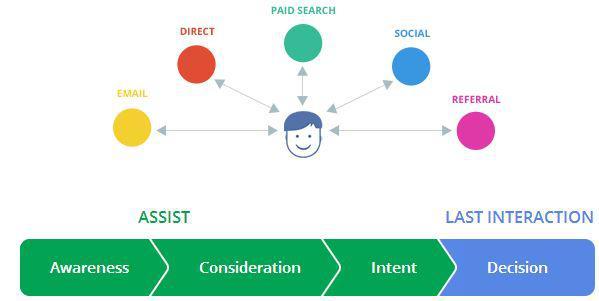Today, we’re posting the final installment of our four-part blog series on the major KPIs to be tracked by B2B companies. We have already covered customer retention and churn, customer lifetime value, and lead funnel performance indicators. This series will finish with the overview of the Cost per Acquisition metric frequently used by B2B eCommerce businesses to evaluate enterprise performance.
Cost per Acquisition Overview
Cost per acquisition (CPA) is a KPI that measures the total cost of acquiring a new paying customer, also known as Customer Acquisition Cost (CAC). The goal of measuring CPA is to analyze how much money does a business have to spend to acquire a new customer while also showing executives which sales and marketing efforts have the best ROI when tracking for each channel.
While CPA can be tracked on a global scale where total sales & marketing costs are divided by the amount of newly acquired customers, our discussion will focus on optimizing CPA across different marketing channels.
Cost per Acquisition Calculation Formula
Apply the Cost per Acquisition calculation formula for each marketing channel separately to identify how much it costs to win a deal via this particular channel:
CPA =
Total costs over a certain time period per specific marketing channel ÷
Number of clients acquired through this marketing channel over the same period
What’s So Difficult About CPA?
The Cost per Acquisition is a key metric for understanding the efficiency of marketing budget spend and estimating the revenue impact brought by certain marketing channels.
Normally, organizations perform a number of marketing promotions originating from different marketing channels (e.g. content marketing, pay-per-click aka PPC, SEO, direct mail listings, email campaigns, events, social media, etc.). These channels in turn have different CPA metrics. The lower the CPA, the better particular channel is. But it gets tricky when we start using the Cost per Acquisition calculation for different channel costs.
Many business owners love PPC advertising and deem this channel the most effective, simply because with every click and impression calculated and reported, it is extremely easy to calculate how much it took for a sale to happen. But the realization many business owners need to face is that SEO, for example, can be cheaper in the long term if they measure its CPA properly.
Consider leveraging metrics like CLV (customer lifetime value) as well as the sales cycle length. These two metrics will help you pinpoint the right cadence for CPA KPI measurement and help recognize the customers with highest return probability. Mind that different marketing channels may yield positive results within different timeframes: some may turn out to be effective immediately (like pay per click advertising) while others may have a delayed and cumulative effect (like SEO efforts, and content marketing). That is why it is so important to calculate your CPA for the timeframe of at least one average lead-to-customer conversion cycle for this particular marketing channel, for example – monthly for PPC, but quarterly for SEO.
It makes no sense to measure the CPA for SEO one month after you launched your website and hired an SEO specialist. In fact, SEO efforts for a new website should be tracked for at least a 6 month duration after the launch. One of the main reasons to do so is the fact that SEO CPA will tend to gradually go down with time, as SEO has cumulative effects. So in 12 months you may find that although you are still spending the same $5k a month on SEO, you now get twice as many sales from this channel per month as you used to 6 months ago. With PPC on the other hand, your budget directly correlates with the outcome every month no matter how long you do it.
Another example is email marketing. This is typically the most attractive marketing channel, as it usually has the lowest CPA. But it would be unwise to direct all your marketing budget to this channel and switch off PPC, PR, SEO and all the other more expensive channels. If you did that you’d soon find that you miss out on new business opportunities. This leads us to another very important realization – in order to be able to correctly measure the ROI and CPA of a marketing channel, it is important to trace the entire history of customer interactions with your business to make sure you don’t just give all the credit to the last marketing channel during the lengthy sales cycle.
Tracking CPA
There are various ways to track CPA, these could be either of the following:
- Using a CRM solution
- Using web analytics tools, such as Google Analytics, for example
- Using promo-codes and creating custom links for the internal campaigns
- Asking recently won customers to specify how they learned about a campaign, etc.
There’s no universal method to be chosen, but some of them tend to be more painless and expedient than the rest. The tool that is actually designed to keep track of all the necessary info and can perform appropriate calculations and provide relevant reports is the CRM.
Reducing CPA
Reducing the CPA is something all businesses crave for. Compared to the revenue increase, cutting expenses is always easier and the lower hanging fruit. And there are several ways to approach this issue:
- Constantly work on your website’s UX, conduct A/B tests to make sure you are improving traffic to increase the conversion rate.
- Work with your sales team, make sure they have everything they need for effective lead to opportunity and to customer conversion.
- Monitor churn rates closely, provide proper support to you clients, make sure returning clients are cherished and appreciated.
- Explore Cross- and Upselling techniques.
- Stop targeting locations that generated no revenues over a certain period of time.
- Put on hold some of paid marketing campaigns that have brought no or too few conversions over a certain period of time.
- Retarget the visitors with the abandoned shopping carts with ads and emails.
Conclusion
Finalizing our blog series on the B2B-related KPIs, we’d like to sum up some key points.
- The main idea behind using KPIs is the quantification of your current performance so that you can accurately and succinctly measure how your business is progressing towards its goals over time.
- Because the KPIs highlight company’s critical success factors, you should agree upon tracking them prior to the launch of any of your marketing campaigns and B2B sales strategies and tactics.
We believe that customer retention & churn rates, customer lifetime value, lead funnel performance indicators, and cost per acquisition KPIs should be tracked by nearly any B2B eCommerce company despite the fact that there are no universal metrics equally valuable and informative for everyone. More complex scenarios such as B2B marketplaces have additional B2B marketplace metrics that must be tracked. In either case, the abovementioned KPIs provide a very clear high-level picture of how well your business is doing. They also give you a clue as to what key performance indicators you should dig deeper into and what metrics are less relevant for your organization’s success measurement.




